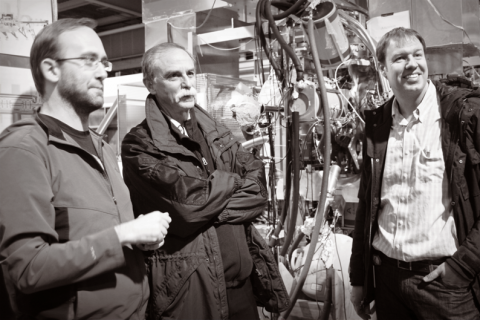
Nobel Laureate, Dr. David Wineland visited TRIUMF in October as part of a trip to Vancouver where he met with collaborators and colleagues. His research is concerned with ion traps and quantum manipulation techniques and overlaps with some of the research conducted at TRIUMF, although TRIUMF scientists work with short-lived, unstable ions. Dr. Wineland met with TRIUMF's "trappers," led by Jens Dilling, head of the TITAN (TRIUMF's Ion Trap afor Atomic and Nuclear science) experiment. [Photo: Brad Schultz (Left), David Wineland (Middle), Jens Dilling (Right) on the platform of TITAN.]
“I was sleeping and my wife got the call and woke me up…it was a wonderful surprise,” he said in an interview with the Nobel committee. Dr. Wineland won the 2012 Nobel Prize for Physics for “ground-breaking experimental methods that enable measuring and manipulation of individual quantum systems.”
Dr. Wineland learned his 'trade' at Harvard University working with Noble Laureate Norman Ramsey and later moved to the National Institute of Standards and Technology (NIST), in Bolder, Colorado (U.S.) where he has headed the Ion Trapping Group for 37 years. One of the main themes of his research has been developing more accurate atomic clocks.
Atomic clocks provide the most accurate time in the world. Similar to mechanical clocks, atomic clocks rely on an oscillating mass and a spring. The difference is that the oscillation occurs between the neutron of an atom and surrounding electrons.
Improving the trapping and cooling of atoms has been one of the primary focuses of modern experimental physics. An ion trap (Nobel Prize to Dehmelt and Paul in 9189) allows scientists to study and manipulate electrically charged particles or ions. The most commonly used ion traps in today's research are the Paul trap and the Penning trap.


Figure 1. Both the a) Paul trap and the b) Penning trap use magnetic fields, electric fields or a combination to isolate single ions.
Ion trapping is performed at TRIUMF with TITAN . TITAN incorporates a Paul trap for cooling and a Penning trap for mass measurement. The Paul trap consists of four linear electrodes, two positive poles and two negative poles positioned across from each other. Their polarity constantly alternates so that any charged particle will be continuously pushed towards the center by the electric forces surrounding it. Meanwhile, the Penning trap consists of a combination of a strong magnetic field and a weak electrostatic field generated by two end caps and a ring electrode, arranged in a geometry that allows a so-called harmonic potential.
TRIUMF salutes Dr. Wineland for his Nobel recognition and thanks him for his seminal contributions to the field. As we press forward with more sophisticated traps that combine multiple technologies, TRIUMF will undoubtedly be calling on his expertise again.
-- by A. Guo, Communications Assistant
